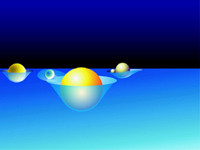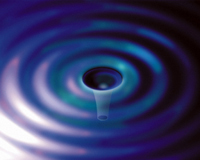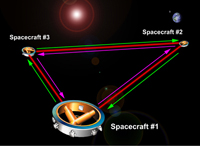Imagine the Universe News - 03 September 2003
Pulsars That Rock Space and Time
| 02 September 2003 |
|
Envision a bright and beautiful spherical rock, about 10 miles across, packed so tightly and spinning so quickly -- at about 20 percent light speed -- that it actually shakes the fabric of space as if it were a bowl of Jello.
This is what might be happening within our own Milky Way galaxy. Using an orbiting NASA telescope called the Rossi X-ray Timing Explorer, scientists have found evidence of nearby pulsars rattling space, producing ripples called gravitational waves.
Albert Einstein predicted the existence of these waves. They are analogous to waves upon an ocean. The waves are extremely subtle, though, causing "buoys" like the Earth and Moon to bob up and down at a distance only about the width of an atom.
|
The faster a pulsar spins, scientists say, the more gravitational waves it creates. This is a very good thing from the pulsar's perspective. The waves act to control the speed of the pulsar, releasing energy and slowing the spin rate. Without the release of gravitational waves, the pulsars would fly apart.
"Nature has set a speed limit for pulsar spins," said Prof. Deepto Chakrabarty of the Massachusetts Institute of Technology, who led the observation. "Just like cars speeding on a highway, the fastest-spinning pulsars could technically go twice as fast. But something stops them before they break apart. That 'something' might be gravitational radiation, preventing the pulsars from destroying themselves."
Admittedly, this is wild stuff, all part of Einstein's amazing legacy. Yet one by one, all of Einstein's theories -- such as black holes that bend light and slow time -- seem to be true.
Chakrabarty's team was very specific in mentioning that they have not directly detected gravitational radiation. No one has... yet. What they found is solid evidence of a maximum pulsar speed, and so far the best explanation is gravitational waves.
Pulsars are the fastest spinning stars in the Universe. They are the core remains of exploded stars, containing the mass of our Sun compressed into a sphere about 10 miles across. They are like spinning marbles in space. Some scientists say they have a fluid core of neutrons or perhaps exotic particles called quarks. Pulsars rank up there with black holes as the strangest objects around.
Some pulsars gain speed by pulling in gas from a neighboring star. They can reach spin rates of nearly one revolution per millisecond. Chakrabarty's team studied 11 of these "millisecond" pulsars. They found none spinning faster than 619 times per second.
The Rossi Explorer is capable of detecting pulsars spinning as fast as 4,000 times per second. Pulsar break-up is predicted to occur at 1,000 to 3,000 revolutions per second. Yet scientists have found none that fast. From a statistical analysis of the 11 pulsars, they concluded that the maximum speed seen in nature must be below 760 revolutions per second. There is clearly a cosmic speed limit.
Prof. Lars Bildsten of the University of California, Santa Barbara, suggested several years ago that pulsars could emit gravitational waves. As the pulsar picks up speed, any slight distortion in the star's dense, half-mile-thick crust of crystalline metal would produce the waves. (Envision a spinning football in water, which would cause more ripples than a spinning, spherical basketball.)
An equilibrium rotation rate is eventually reached where the angular momentum shed by emitting gravitational waves matches the angular momentum being added to the pulsar by its companion star. (The angular momentum of a spinning object is a measure of its mass, the distribution of mass in the object, and how fast it spins)
NASA, the European Space Agency, the National Science Foundation and other institutes are teaming up to detect gravitational waves directly. This would provide an entirely new window to see the Universe. Because the waves hardly interact with matter, they travel freely through the Universe. Light, on the other hand, can get blocked by walls. Gravitational waves from the Big Bang are likely still rippling through the Universe.
One gravitational wave detector on the ground is LIGO, the Laser Interferometer Gravitational-Wave Observatory, now in operation in Hanford, Washington, and in Livingston, Louisiana. LIGO hopes to detect waves at the frequency produced by millisecond pulsars.
|
LISA, the Laser Interferometer Space Antenna, is a three-satellite mission that may be in orbit by 2011. LISA's three satellites, separated by 5 million kilometers and "tethered" by lasers, would act like buoys detecting passing waves from supermassive black hole mergers.
These gravitational waves are passing through you right now, squeezing your body and then expanding it ever so slightly. It's a bizarre Universe just waiting to be discovered.




